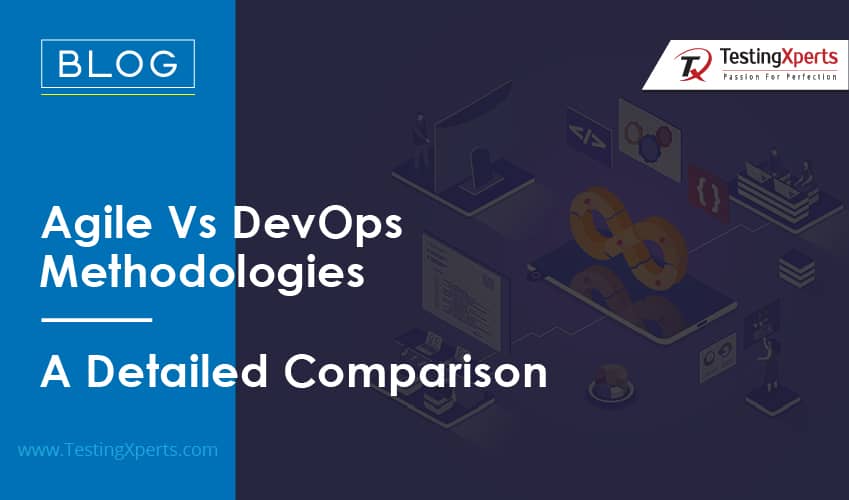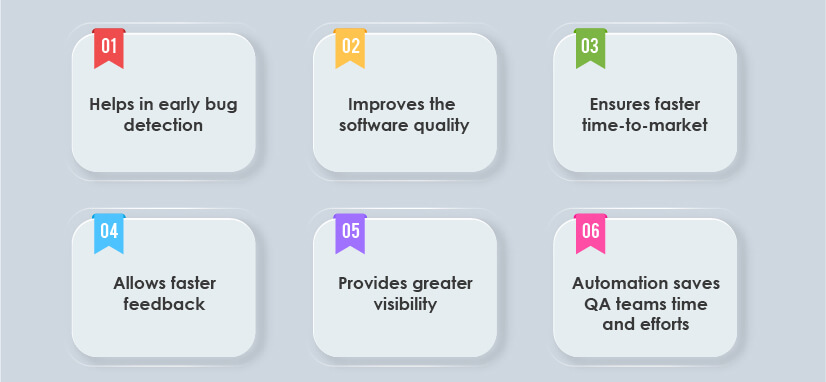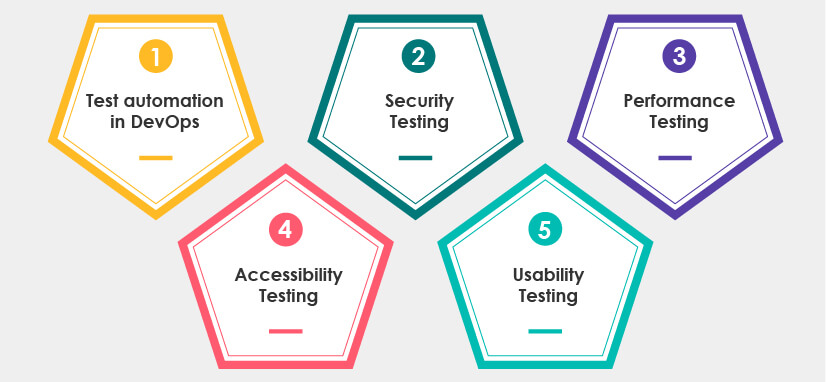Recommended Blogs
Agile Vs DevOps Methodologies – A Detailed Comparison

Today, every enterprise needs high-quality products and faster time-to-market to deliver a great customer experience (CX). But for businesses to fulfil the rising need for high-quality products, adoption of the latest and robust software development and testing methodologies is necessary. This is where the agile and DevOps methodology comes into the picture.
The agile methodology plays a significant role in improving the team’s productivity with its iterative model. Whereas, DevOps methodology ensures effective collaboration between the development (Dev) and the operations (Ops) teams. Since Agile and DevOps methodologies are critical for enabling faster and quality releases, businesses are adopting them rapidly.
Content 1. Overview of Agile and DevOps Methodologies 2. Agile Vs DevOps Methodologies – Detailed Comparison 3. Various Phases of Agile and DevOps Lifecycle 4. How has the Journey from Agile to DevOps helped Businesses? 5. Significance of DevOps CI/CD Implementation in today’s Agile Environment 6. Major Software Testing Types for Successful DevOps CI/CD Implementation 7. Conclusion 8. How Can TestingXperts (Tx) help?
Overview of Agile and DevOps Methodologies
Agile Methodology
It is a software testing methodology that is guided by certain principles stated in the agile manifesto for software development. This methodology follows an incremental/iterative approach, and the main aim of this approach is to deliver quality software. It also involves continuous collaboration between stakeholders and teams and ensures continuous improvement of product’s quality. Moreover, in this approach, the software is developed and tested in small stages known as sprints, and each sprint varies from 1-3 weeks.
DevOps Methodology
This methodology aims to break traditional silos between cross-functional teams in the waterfall model. It is an evolution from agile methodology and is an enterprise software development and testing approach that emphasizes collaboration and communication between cross-functional teams. This approach involves continuous development, continuous integration, continuous testing, continuous delivery, and continuous monitoring processes to ensure faster releases and high-quality software.
Agile Vs DevOps Methodologies – Detailed Comparison
| The main purpose of the methodology | This methodology helps teams to manage projects easily by involving the stakeholders in the SDLC. Customer feedback and suggestion helps developers and testers to improve the product quality. | This methodology helps to break traditional silos that earlier existed between cross-functional teams and encourages team members to work in close collaboration with each other with a faster feedback loop. |
| Delivery | Product is delivered in increments after the completion of each sprint (one sprint usually lasts for 1-3 weeks). | The goal is to provide continuous delivery of products by enabling CI/CD pipeline. |
| Teams | This methodology focuses on keeping the teams small. It includes people with similar skill sets in one team. | In this methodology, team size is relatively bigger as it combines cross-functional teams into one team and ensures seamless collaboration between teams. |
| Feedback | Focuses on customer feedback and ensures quality product delivery. | Feedbacks are gathered from internal teams and stakeholders that help to improve and speed up the product delivery. |
| Tools | Kanboard, JIRA, Slack, Trello, Bugzilla, etc. | Git, Puppet, AWS, OpenStack, Docker, Jenkins, Kubernetes, etc. |
Various Phases of Agile and DevOps Lifecycle
| 1. Requirements – It involves planning and gathering all initial requirements like product features, functionalities, expected results, etc., that are necessary for starting the agile software development and testing process. | 1. Continuous Development – This phase involves planning the requirements and coding the software. |
| 2. Design – In this phase, architectural design and the visual design of the software is finalized | 2. Continuous Integration – In this phase, the developer frequently commits changes to the source code daily or weekly. Bugs in the source code are detected early, and new codes with more functionalities are integrated into the software. Also, teams (developer & testers) use various tools for unit testing, code review, integration testing, compilation, and packaging. |
| 3. Development and Coding – It involves writing the code and converting the design into actual software | 3. Continuous Testing – In this phase, the developed software is tested for bugs. The test environment is simulated by leveraging Docker containers. It also involves UAT testing along with other types of tests. The teams leverage continuous testing tools like TestNG, Selenium, JUnit, etc. |
| 4. Integration and Testing – This stage involves integrating the various components of the software. The software is then tested to ensure it is bug-free and works as expected. With iteration, the testing becomes wider in scope and involves integration, interoperability, User Acceptance Testing (UAT), etc. | 4. Continuous Feedback- It involves gathering feedback from the developers, operations team, and end-users/stakeholders which helps in improving the quality of the software. |
| 5. Implementation and Deployment- The software is deployed on the server and delivered to the customers for a demo or actual use as a part of the UAT. | 5. Continuous Monitoring – It is essential to continuously monitor the software’s performance to ensure all the functionalities work properly. Some of the continuous monitoring tools used in this process are Nagios, Splunk, Sensu, etc. |
| 6. Review – Once all the previous steps are completed, the product owner reviews the progress. The product is then launched into the market after the complete satisfaction of the stakeholder. | 6. Continuous Deployment – In this methodology, the code is continuously deployed to the production servers. Some of the configuration management tools include Chef, Puppet, Ansible, etc., and containerization tools like Docker, Kubernetes, Ant Maven, etc., that can be used during this process. |
| 7. Continuous Operation – This step aims to automate the process of releasing the application and the subsequent updates. Development cycles in continuous operations are shorter, which allows developers to accelerate the time-to-market continuously. | |
| 8. Continuous Delivery- This is the final stage of the entire process that automates the process of deploying new builds into the production. The goal of this phase is to perform automated testing on each build and verify the build that is ready for production. It involves automatic provisioning and configuration of the test environment as well as testing of these environments. It deploys a new release into production post all bugs get fixed |
How has the Journey from Agile to DevOps helped Businesses?
In 2001, the agile manifesto had its birth which gave rise to the agile methodology. This manifesto contained certain values and principles that guide developers and testers to break the project into smaller parts, accelerate feedback loops and align product features with customer needs. The early adopters of agile methodology were small software start-ups that were eager to disrupt the market and were willing to take the risk. As this methodology matured, large enterprises started adopting it. The agile approach worked fine for some time as it helped developers to produce software in smaller parts. But later, it was realized that it lacks the capability of continuous testing and continuous delivery.
Due to the rising need for faster releases, high-quality software and faster time-to-market, businesses needed advanced methodologies such as DevOps processes. Companies started shifting from Agile to DevOps methodology as it helped them in many ways as listed below:
Significance of DevOps CI/CD Implementation in today’s Agile Environment

CI/CD stands for Continuous Integration (CI) and Continuous Delivery (CD), wherein a modern software coding philosophy allows developers to implement small changes and check code frequently. The main goal of CI is to establish a consistent and automated way to build, package, and test applications. CD is closely related to CI and enables automation of the entire software delivery process by leveraging automation tools. Further, it commits and delivers the integrated code into the production stage without any bugs or delays.
Both CI and CD are the backbone of today’s DevOps environment. There are various benefits that businesses can leverage by implementing the DevOps CI/CD pipeline.
• Helps in early bug detection –
Automated tests enabled by implementing CI/CD pipeline helps to detect bugs early in the SDLC.
• Improves the software quality –
Faster bug detection ensures faster bug-fixing and ultimately helps to ensure secure and reliable software.
• Ensures faster time-to-market-
Enabling CI/CD pipelines helps to increase the speed of software delivery considerably. It further helps businesses to reach the market faster and achieve a competitive edge.
• Allows faster feedback –
Typically, for any changes committed to the code, tests are run simultaneously, which helps to avoid any link breakage. Faster feedback through CI tools helps to check and improve the product quality.
• Provides greater visibility –
The CI/D pipelines give greater visibility of the entire DevOps process. This helps teams analyze the processes of software build, test results, and issues effectively.
• Automation saves QA teams time and efforts –
Automated CI/CD pipelines frees up team members so that they can focus on more important tasks and innovation. This ultimately saves their time and testing efforts.
Evidently, for businesses to reap complete benefits, they should embark on scalable CI/CD DevOps implementations by leveraging various software testing methods.
Major Software Testing Types for Successful DevOps CI/CD Implementation

1. Test automation in DevOps-
Test automation is the backbone of the DevOps process. Therefore, businesses must leverage automated testing using various open-source and commercial tools to ensure continuous testing and the continuous delivery of software.
2. Security Testing –
This methodology lays a strong emphasis on security. Businesses must leverage security testing to safeguard software from threats and vulnerabilities.
3. Performance Testing –
To ensure software delivers a great CX even under heavy loads, businesses must leverage performance testing. This testing method helps businesses to improve the performance and load handling capacity of the software.
4. Accessibility testing –
Businesses must also leverage accessibility testing to ensure equal access to apps for all users, including people with certain disabilities like hearing impaired, impaired vision, cognitive limitations, etc.
5. Usability Testing –
Businesses need to ensure that the apps have an easy-to-use interface and proper navigation for enabling a great CX. To achieve seamless apps, businesses must leverage usability testing.
Conclusion
Businesses are rapidly moving towards DevOps methodology for various reasons. Firstly, it is an evolution from agile methodology thus making it easier for today’s businesses to adopt it. Secondly, this methodology allows businesses to reach the market faster and improve organizational culture. Lastly, it ensures great customer satisfaction, which is the need of the hour for all businesses. Businesses must leverage test automation in DevOps from the next-gen QA and independent software testing services provider for successful DevOps implementation and faster delivery of high-quality products.
How Can TestingXperts (Tx) help?
TestingXperts (Tx) has been at the forefront in enabling test automation in DevOps services using the latest software test automation tools and also with an in-house accelerator, ‘Tx-Automate.’ Our test automation services best support business objectives by enabling an effective test automation strategy that is aligned with enterprise’s business goals.
Our Differentiators:
• Certified automation experts with expertise in implementing advanced automation frameworks with 500+ testers
• Standardized processes, templates, and toolkits for Agile and DevOps QA
• A global team of QA professionals with a capability to scale up at both onsite and offshore
• Dedicated DevOps expert teams ensure scalable, secure, and reliable testing services
• Ensure automation with deployments and rollbacks performed in a click with low risks and high productivity
• Deliver hassle-free project management with flexible engagement models
• Recommend the best DevOps toolchain that best suits your project model
• Focus closely on user security and protection
• Expertise in industry-leading test automation (UFT, Selenium, TestComplete, Coded UI, etc.), Agile development tools (Rally, Scrumdo), and CI/CD tools ( Jenkins, Chef, Puppet, TFS, Hudson, Go, Bamboo, etc.), providing DevOps lifecycle automation
• Enable continuous support and training for client teams
Discover more
Stay Updated
Subscribe for more info
